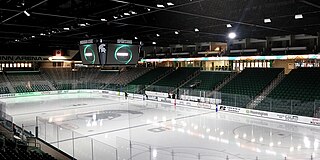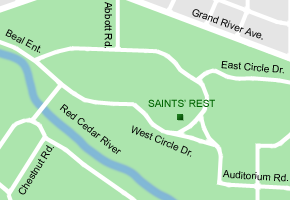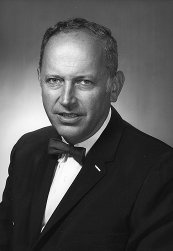
Michigan State University is a public land-grant research university in East Lansing, Michigan, United States. It was founded in 1855 as the Agricultural College of the State of Michigan, the first of its kind in the country. After the introduction of the Morrill Act in 1862, the state designated the college a land-grant institution in 1863, making it the first of the land-grant colleges in the United States. The college became coeducational in 1870. Today, Michigan State has facilities all across the state and over 634,000 alumni.

Sparty is the mascot of Michigan State University. Sparty is usually depicted as a muscular male Spartan warrior/athlete dressed in stylized Greek costume. After changing the team name from "Aggies" to "Spartans" in 1925, various incarnations of a Spartan warrior with a prominent chin appeared at university events and in university literature. In 1943, MSU art professor Leonard D. Jungwirth designed a statue for the university, which had to be cast in terra cotta because of World War II rationing. In 2005, the university replaced Jungwirth's original statue with a bronze replica, moving the original indoors to protect it from the elements.

Spartan Stadium is an outdoor stadium in East Lansing, Michigan, United States that opened in 1923. It is primarily used for football, and is the home field of the Michigan State University Spartans. After the addition of luxury boxes and club seating in 2004–2005, the capacity of the stadium grew from 72,027 to 75,005—though it has held more than 80,000 fans—making it the Big Ten's sixth largest stadium. It has been nicknamed "The Woodshed".

The Jack Breslin Student Events Center is a multi-purpose arena at Michigan State University in East Lansing, Michigan. The arena opened in 1989, and is named for Jack Breslin, MSU alumnus, former athlete and administrator, who first began pushing for the arena in 1969. It is home to the Michigan State Spartans men's and women's basketball teams. Although it nominally contains 16,280 seats, the arena typically holds around 10,000 for most events depending on the floor or stage setup. The Breslin Center superseded Jenison Fieldhouse, which stands approximately 400 feet (120 m) to the northeast, which had served since 1939. In 2022 the women's volleyball team moved its home games from Jenison to the Breslin Center.

Clarence L. Munn Ice Arena is a 6,114-seat hockey-only arena in East Lansing, Michigan on the campus of Michigan State University, situated across Chestnut Road from the Intramural Recreative Sports Center West and Spartan Stadium. It is home to the MSU's ice hockey team. Completed in 1974, the arena is named in honor of former MSU football coach and athletic director Clarence "Biggie" Munn.

Agganis Arena is a 7,200-seat multi-purpose arena in Boston, Massachusetts, United States, on the campus of Boston University, built on the location of the former Commonwealth Armory. It is home to the five-time national champion Boston University Terriers men's ice hockey team. It is named after Harry Agganis, a football and baseball player for BU. The ice hockey rink is named Jack Parker Rink, after the legendary BU hockey player and coach. The arena is part of Boston University's John Hancock Student Village, which also includes dormitories and the university's five-story Fitness and Recreation Center.

Saints' Rest was the second building erected on the campus of the Agricultural College of the State of Michigan. It was built in 1856 and served as the school's only dormitory until 1870, when Williams Hall was completed. Along with College Hall and a horse barn, it was one of three buildings completed when the college opened for classes in 1857.

College Hall was the first building erected on the campus of the Agricultural College of the State of Michigan, and the first in the United States to be erected "for the teaching of scientific agriculture." Reputedly designed by John C. Holmes, it was built in 1856 and housed the school's classrooms, offices and laboratories, the school's library/museum, and a multifunction lecture hall/chapel. Along with Saints' Rest, and a horse barn, it was one of three buildings completed when the college opened for classes in 1857.

The Beaumont Tower is a structure on the campus of Michigan State University, designed by the architectural firm of Donaldson and Meier and completed in 1928. The 104-foot-tall (32 m) tower marks the site of College Hall, the first building constructed on the campus, as well as the first building in America erected for instruction in scientific agriculture. Due to poor construction, College Hall collapsed in 1918. John W. Beaumont, an 1882 alumnus of MSU, proposed the construction of the monument to conserve the Campus Circle and serve as a monument to teaching.

Jenison Fieldhouse is a 10,004-seat, later reduced to 6,000-seat, multi-purpose arena in East Lansing, Michigan. The arena opened in 1940 and was named for alumnus Frederick Cowles Jenison, whose estate, along with PWAP funds, funded the building. It was home to the Michigan State University Spartans basketball team before they moved to Breslin Center in the fall of 1989. Previously Michigan State College (MSC) basketball had played home games at Demonstration Hall and the IM Circle buildings.

The campus of Michigan State University is located in East Lansing on the banks of the Red Cedar River, and comprises a contiguous area of 5,200 acres (21 km2), 2,000 acres (8.1 km2) of which are developed. Built amid virgin forest, the campus opened in 1855 with three buildings, none of which remain. As an agricultural college, the campus was originally located several miles outside of the city of Lansing, but as the population of the college grew, the city of East Lansing developed just north of the area's main avenue.

The Michigan State Spartans are the athletic teams that represent Michigan State University. The school's athletic program includes 23 varsity sports teams. Their mascot is a Spartan warrior named Sparty, and the school colors are green and white. The university participates in the NCAA's Division I and the Football Bowl Subdivision for football. The Spartans participate as members of the Big Ten Conference in all varsity sports. Michigan State offers 11 varsity sports for men and 12 for women.

Ronald Herbert Mason was a Canadian ice hockey player, head coach, and university executive. A head coach of various American universities, most notably Michigan State University (MSU), he was the most successful coach in NCAA ice hockey history between 1993 and 2012 with 924 wins, until Jerry York became the new winningest coach with his 925th career win on December 29, 2012. Mason was athletic director at MSU from 2002 to 2008. He then served as senior advisor for the USHL Muskegon Lumberjacks. On December 2, 2013, Mason was inducted into the United States Hockey Hall of Fame.

The Cold War was a college ice hockey game played between U.S. college rivals Michigan State University and the University of Michigan on Saturday, October 6, 2001. It set a then-world record for the largest crowd at an ice hockey game with 74,544.

The Michigan State Spartans football program represents Michigan State University (MSU) in college football at the NCAA Division I Football Bowl Subdivision (FBS) level. The Spartans are members of the Big Ten Conference. Michigan State claims a total of six national championships, including two from the major wire-service: AP Poll and/or Coaches' Poll. The Spartans have also won eleven conference championships, with two in the Michigan Intercollegiate Athletic Association and nine in the Big Ten.

Walter Adams was an Austrian-born American economist and college professor. He served as the 13th President of Michigan State University and served as an expert witness before 36 congressional committees.

Amos "Betts" Bessone was a collegiate ice hockey player and head coach.

The Michigan State Spartans men's ice hockey team is the college ice hockey team that represents Michigan State University (MSU). The team plays at the Munn Ice Arena in East Lansing, Michigan, on the MSU campus. The Spartans have won the NCAA national championship three times. The current head coach is Adam Nightingale, who took over coaching duties on May 3, 2022, after Danton Cole was fired. Michigan State currently competes in the Big Ten Conference.

The Michigan–Michigan State men's ice hockey rivalry is a college ice hockey rivalry between Michigan Wolverines men's ice hockey and Michigan State Spartans men's ice hockey that is part of the larger intrastate rivalry between the University of Michigan and Michigan State University. It constitutes the most-played rivalry in college hockey. The rivalry between the Spartans and Wolverines notably includes football and basketball rivalries, although it extends to almost all sports and many other forms of achievement.

Bowd–Munson Company was an architectural firm in Lansing, Michigan. The firm was a partnership between Edwyn A. Bowd and Orlie Munson.






















